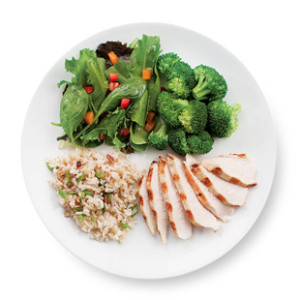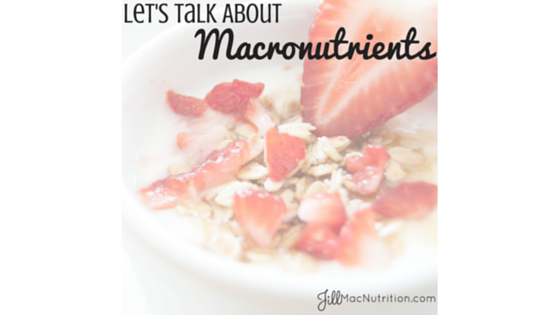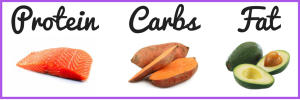There’s so much debate about macronutrients (protein, carbohydrates, and fat) and how much of each we should be eating. Some swear by low-carb and ketogenic diets. Some say low-fat is the way to go. There are high-protein diets, high-carb diets, high-fat diets – so which one is correct? I’ll let you in on a little secret (okay it’s not really a secret), the answer is none of them.
There are no perfect macronutrient ratios that are right for everyone. We are bio-individuals. We all have different goals, health issues, body types, lifestyles, etc. So while my plate may be mostly carbs and protein with some fat, yours might be mostly fat and protein with little carbs. It all depends on the individual person.
After eating, if you’ve had the correct macronutrient ratios for your body, you will:
- be satisfied and full
- have no cravings for sweets
- have no desire to eat more
- not need to snack between meals
- not be hungry soon after eating
- have long lasting, stable energy
- have improved mood after eating
- feel restored/refueled
- have improved clarity of mind
- have better emotion balance
After eating, if you did not have the correct macronutrient ratios for your body, you will:
- be full but not satisfied
- crave sweets
- feel hungry soon after eating
- need to snack between meals
- have either too much or too little energy
- be jittery, nervous, shaky, hyper, and/or anxious
- feel hyper but exhausted underneath
- feel tired, exhausted, lethargic, drowsy
- feel mentally sluggish and spacey
- feel fog brained, unable to think clearly
- unable to focus
- depression, sadness, apathy
- anxiety, irritability, anger, obsessive behavior
It takes trial and error to figure out which ratios will work for you. When working with clients, I start them out at 30% protein, 30% fat, and 40% carbohydrates and tweak it as necessary. I’m still experimenting on myself, but I generally do better with higher carb, lower fat.
Use the bullet points above to test where you’re at. Keeping a food journal is a great way to keep track of what you’re eating, macronutrient amounts, and how you’re feeling. You can measure your progress as you’re figuring out what works for you and if you start feeling “off” again one day, you can look back and see what changed.
| Protein | Carbohydrates |
Fat |
|
|
|
Eating a healthy, balanced diet is more than just macronutrients. Micronutrients are also vital to our health (vitamins and minerals) and food quality/nutrient density is the most important. Focus on food quality/nutrient density first, and then play with macronutrient ratios.
Generally, those who exercise need more carbohydrates than people who don’t and women tend to need more carbohydrates than men. But as I mentioned, we’re all different. There are certainly men who do better with more carbs and women who do better with less.
- Fuel for the brain
- Quick burning energy for muscles
- Helps to regulate protein & fat metabolism
- Contains fiber for regular bowel movements
- In conjunction with protein & fat: help fight off infections, promotes growth of body tissues, lubricates joints
- Enzymes: Protein molecules that are managers and catalysts for all biochemical processes. Basically, they start all processes in the body. For example, digestive enzymes.
- Antibodies: Proteins that fight infections
- Hemoglobin: Specialized proteins – red blood cells that carry oxygen
- Hormones: Proteins that regulate metabolism & pretty much every function in the body
- Provides a source of long-burning energy.
- Building blocks for our hormones and cell membranes
- Stimulates the release of bile from the gallbladder during digestion.
- Needed to absorb the fat soluble vitamins A, D, E, and K.
- Needed in order to properly absorb and utilize proteins
- Stored fat protects our organs
- Slows the absorption of food during digestion, keeping us full & satisfied longer
- Makes food taste good
Start out with a plate that looks like this: 
Make half your plate vegetables and the other half protein, fat, and starchy carbs. Keep a food journal, note amounts, and how you feel. Make changes as necessary. If you’re having trouble figuring out what works for you, you may want to consider one-on-one nutrition consulting.
Have some thoughts? Drop a comment below!
See Also:
Do You Get Hangry?
The Problem With Grains (& how to properly consume them)
Saturated Fat is Actually a Health Food






